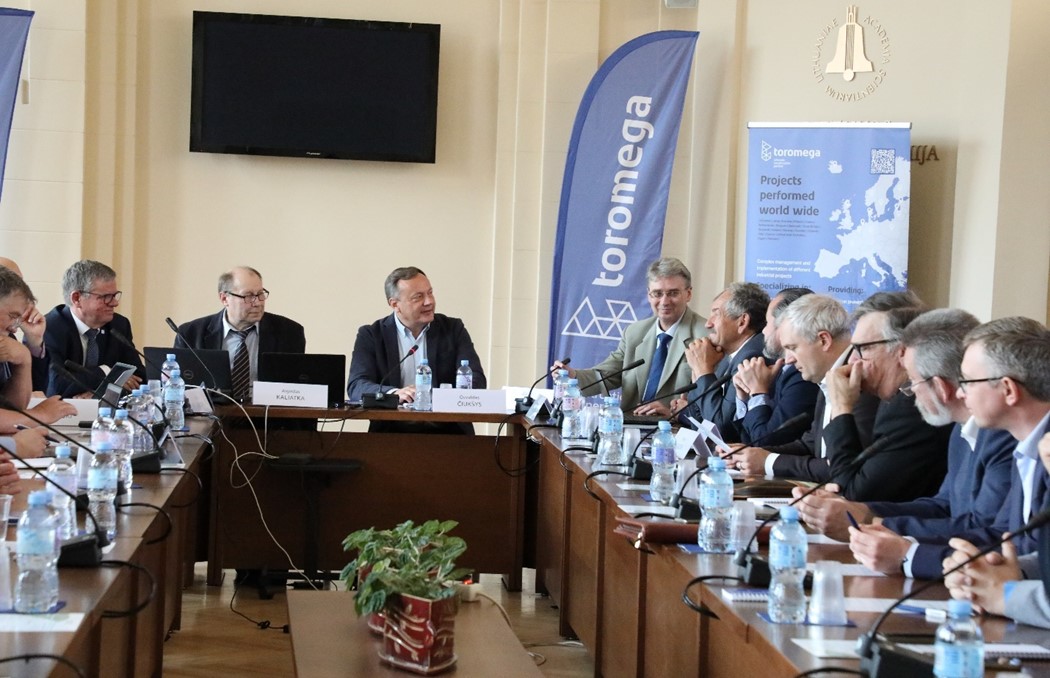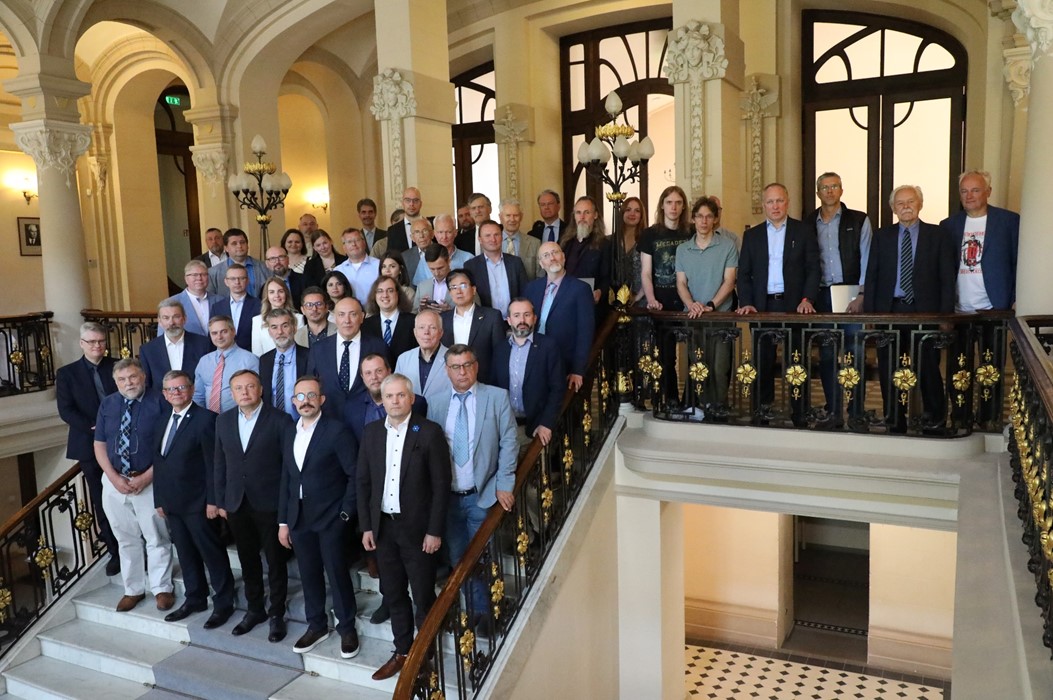International conference "New Trends of Nuclear Reactors: Small Modular Reactors. Experience of Leading Countries and Developers”

Lithuanian Nuclear Energy Association in co-operation with the Lithuanian Academy of Sciences and Lithuanian Energy Institute organized the international conference "New Trends of Nuclear Reactors: Small Modular Reactors. Experience of Leading Countries and Developers”. Representatives of 5 ETSON organisations (LEI, JSI, VTT, ENEA, EK-CER) took participation in the conference.
The main objectives of the Conference highlighted the attractive features of SMRs, major challenges, the current status of SMR technology and near-term deployment plans. Lithuanian and foreign businesses also contributed to the organization of the conference. The Conference took place on 15th of June, 2023 in Vilnius, the capital of Lithuania. It was attended by key academia, business and politicians of Lithuania, Small Modular Reactors technology leaders from all over the world. The participants of the conference also include the Lithuanian Energy Agency, the Lithuanian State Nuclear Power Safety Inspectorate, the Ministry of Foreign Affairs, the Ministry of Energy of the Republic of Lithuania, the Ignalina NPP. The representatives of Universities, Scientific Research Institutes, the NATO Energy Security Centre of Excellence, the Ambassadors and representatives from the embassies of Japan, Poland, Estonia and Denmark also participated.
The conference was opened by the president of the Lithuanian Nuclear Energy Association and the greetings from the president of the Lithuanian Academy of Sciences. Also, the greeting's speech of president of the European Nuclear Society, Leonas Cizelj, welcomed the participants of the conference.
Small Modular Reactors (SMRs) are one of the key options for the near-term deployment of new nuclear reactors. Currently in Europe there is a growing interest towards the deployment of SMRs, and several activities are underway in many countries preparing for possible licensing needs.
The work in the conference was divided into four sections. The first section was devoted to the current status of SMR technology and near-term deployment plans. In this section, the introductory speech "Advances in small modular reactor technology. Developments for near term deployment" was given by Dr. M. Hadid Subki, Technical Leader for SMR Technology Development, International Atomic Energy Agency. Berta Picamal Vicente, Legal and International Relations Director at NUCLEAREUROPE, spoke about nuclear energy perspectives in the European Union, the development of SMRs and the European SMRs partnership. The topic of SMRs development was further extended by Prof. Wacław Gudowski, Senior Advisor to Management Board, ORLEN Synthos Green Energy. He presented the perspectives of the SMRs implementation program in Poland.
The second section of the conference was devoted to SMRs safety analysis carried out in EURATOM program projects. In the introduction, Professor and President of the European Nuclear Society, Leonas Cizelj, discussed the future of nuclear energy, which he believes is in the hands of young nuclear enthusiasts and professionals. This speech generated considerable interest among high school professors participating in the conference. Dr. Szogradi Marton, research scientist at VTT Technical Research Center of Finland, which is leading the implementation of the ELSMOR project to prepare for the licensing of European small modular reactors, spoke about the achieved results in the project. Similar project SASPAM-SA (Safety analysis of SMRs with passive mitigation strategies - severe accident) was discussed by Dr. Fulvio Mascari, ENEA, who is the coordinator of this project. The HARMONISE (Towards Harmonization in Licensing of Future Nuclear Energy Technologies in Europe) project is dedicated to the licensing of various technologies, the coordinator is the Lithuanian Energy Institute. The goals and first results of this project were presented by Egidijus Urbonavičius (LEI). The Lithuanian Energy Institute participates in the implementation of SASPAM-SA, ELSMOR and HARMONISE projects. LEI is also participating in important IAEA research Project “Numerical Modelling of Phenomena in Passive Systems Based on Natural Convection”, which forms the part of IAEA CRP “Design and Performance Assessment of Passive Engineered Safety Features in Advanced Small Modular Reactors (SMRs)”. The objective of this project is the development of common approaches to design and enhance the performance of passive safety features in integral-PWR SMRs.
The third section of the conference discussed the situation of nuclear energy in different EU countries. Mr. Paweł Gajda, Assistant Professor at University of Scientist and Technology, the Polish Nuclear Society presented nuclear energy projects in Poland. Dr. Fulvio Mascari (ENEA) and Szogradi Marton (VTT) spoke about nuclear safety research in Italy and nuclear energy projects in Finland. Poland's ambitious nuclear power projects have sparked considerable debate in the audience, and the low-temperature water-heating nuclear reactor being developed in Finland has also attracted interest.
The last, fourth section was devoted to presentations by SMRs developers and vendors. Business developer Alba Arregui at Seaborg Technologies presented Seaborg's CMSR Power company developed a barge that will install molten salt cooled modular reactors, also Fredrik Vitaback from GE Hitachi Nuclear Energy spoke about the perspectives of deployment of the small modular reactor BWRX-300. The audience was interested in the financial aspects of these proposed concepts (cost of construction as well as cost of produced electricity and heat). The presentations by Kalev Kallemets (CEO of Fermi Energia AS) and Jarosław Dybowski, Vice-President of the Management Board of PKN ORLEN and Executive Director for Energy at ORLEN Synthos Green Energy, were very engaging. The first focused on energy prices using SMRs in the Baltic States and the second detailed the BWRX-300 selection in Poland. These reports were of strong interest to Lithuanian participants, because the experience of our neighbours was presented.
The conference individual sections were led by LBEA president Osvaldas Čiukšys, LEI director Sigitas Rimkevičius and LEI scientists Algirdas Kaliatka and Tadas Kaliatka. The SMRs topic and discussions, interviews and other supporting events are already generating great attention from the leading professionals, experts, and Nuclear Industry leaders from different countries as well as the local and international business community therefore it’s decided to organize similar events in the future.

Algirdas Kaliatka
LEI
Algirdas.Kaliatka@lei.lt